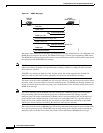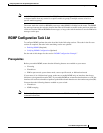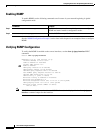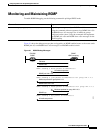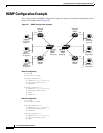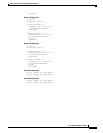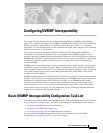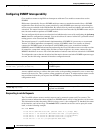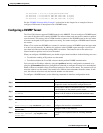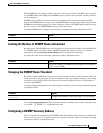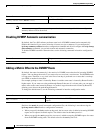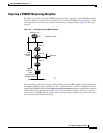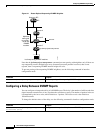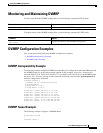
Configuring DVMRP Interoperability
Basic DVMRP Interoperability Configuration Task List
IPC-538
Cisco IOS IP Configuration Guide
Configuring DVMRP Interoperability
Cisco multicast routers using PIM can interoperate with non-Cisco multicast routers that use the
DVMRP.
PIM routers dynamically discover DVMRP multicast routers on attached networks. Once a DVMRP
neighbor has been discovered, the router periodically sends DVMRP report messages advertising the
unicast sources reachable in the PIM domain. By default, directly connected subnets and networks are
advertised. The router forwards multicast packets that have been forwarded by DVMRP routers and, in
turn, forwards multicast packets to DVMRP routers.
You can configure which sources are advertised and which metrics are used by configuring the ip dvmrp
metric interface configuration command. You can also direct all sources learned via a particular unicast
routing process to be advertised into DVMRP.
The mrouted protocol is a public-domain implementation of DVMRP. It is necessary to use mrouted
Version 3.8 (which implements a nonpruning version of DVMRP) when Cisco routers are directly
connected to DVMRP routers or interoperate with DVMRP routers over an multicast backbone
(MBONE) tunnel. DVMRP advertisements produced by the Cisco IOS software can cause older versions
of mrouted to corrupt their routing tables and those of their neighbors. Any router connected to the
MBONE should have an access list to limit the number of unicast routes that are advertised via DVMRP.
To configure the sources that are advertised and the metrics that are used when DVMRP report messages
are sent, use the following command in interface configuration mode:
A more sophisticated way to achieve the same results as the preceding command is to use a route map
instead of an access list. Thus, you have a finer granularity of control. To subject unicast routes to route
map conditions before they are injected into DVMRP, use the following command in interface
configuration mode:
Responding to mrinfo Requests
The Cisco IOS software answers mrinfo requests sent by mrouted systems and Cisco routers. The
software returns information about neighbors on DVMRP tunnels and all of the interfaces of the router.
This information includes the metric (which is always set to 1), the configured TTL threshold, the status
of the interface, and various flags. The mrinfo EXEC command can also be used to query the router
itself, as in the following example:
mm1-7kd# mrinfo
171.69.214.27 (mm1-7kd.cisco.com) [version cisco 11.1] [flags: PMS]:
171.69.214.27 -> 171.69.214.26 (mm1-r7kb.cisco.com) [1/0/pim/querier]
171.69.214.27 -> 171.69.214.25 (mm1-45a.cisco.com) [1/0/pim/querier]
171.69.214.33 -> 171.69.214.34 (mm1-45c.cisco.com) [1/0/pim]
171.69.214.137 -> 0.0.0.0 [1/0/pim/querier/down/leaf]
Command Purpose
Router(config-if)# ip dvmrp metric metric [list
access-list] [protocol process-id]
Configures the metric associated with a set of destinations for
DVMRP reports.
Command Purpose
Router(config-if)# ip dvmrp metric metric
[route-map map-name]
Subjects unicast routes to route map conditions before they are
injected into DVMRP.



